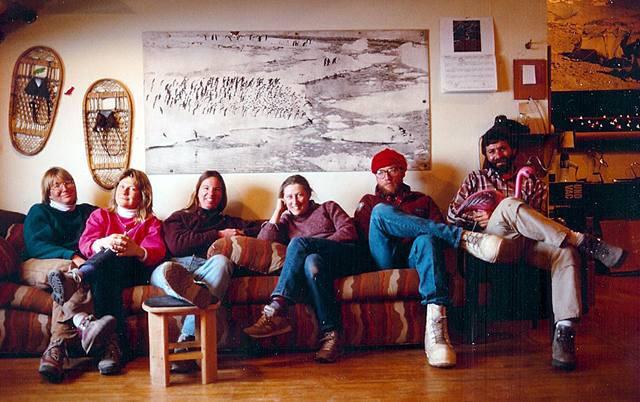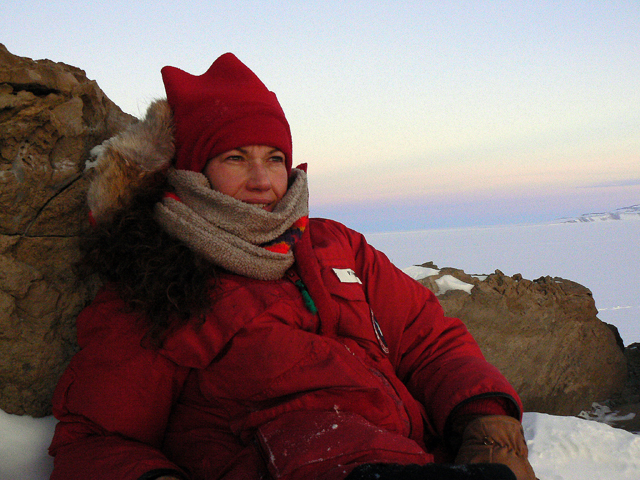|
Page 2/2 - Posted November 13, 2009
A tipping point in the 1990sNo woman served in a significant leadership role until 1986, when Peoples took over management of the Berg Field Center (BFC), which outfits science parties and helps coordinate outdoor fieldwork. That was a big deal, Peoples explains, as some folks balked at the idea of a woman running a department charged with search and rescue responsibilities. She must have done a pretty good job in the end — women have generally run the BFC for more than 20 years now. Peoples continued to push the ceiling that Marty butted against in the 1970s, opening doors for others to follow. In 1990, she became the first woman to hold the position of logistics manager. Ironically, she couldn’t get a grunt-level job in the department years before because of concerns that a woman couldn’t handle 50-pound loads. The next year, she became the first woman to lead one of the three USAP research facilities, serving as station manager at Palmer “In 1981, women on the Ice were still a novelty. By the time I left in 1995, having women on the Ice was normal,” Peoples says. “No one thought too much about it; women routinely contributed to USAP in all aspects of science and support. That change was a good thing. To be part of that change was an adventure and a privilege.” When was the tipping point? It’s hard to say. But maybe it was the 1993-94 season. Peoples was once again station manager at Palmer. Janet Phillips headed South Pole Station for a year. And Karen Schwall ran McMurdo Station. Three station managers, three women. There were only seven women in the U.S. Senate in 1993. (Today there are 17 out of 100 senators.) In an article written for Women’s History Month and later reprinted on Bill Spindler’s South Pole Station Web site “Something made me want to share our little moment in history with people … to let people know that things like this can happen ... to encourage young women, and those young at heart, to strive for what they want, because it can happen. The convergence of women managing the stations at the same time was very brief, a few weeks or so. But the way we look at it, it was a first, a moment to be noticed, a moment to be repeated.” All those Antarctic “firsts” are nice, Peoples concedes, but the legacy of bringing more women into the program is what’s really special to her today. “When I think of the Antarctic, I think of the number of women I worked with, many of whom I hired, that are still in polar programs,” she says. “Helping to open the door for hard-working, competent women who have made a successful career in polar programs holds more satisfaction than all the various ‘firsts.’” Currently field support coordinator at McMurdo Station for her 20th season on the Ice, Hill is one of the many Antarctic alumni from those days. And she is one of a couple hundred women filling any number of jobs today. Yes, women still drive shuttles, but they also manage research labs and rappel down ice cliffs. “I look at McMurdo now compared to 25 years ago, and think that it’s pretty close to normal living in any small community stateside,” Hill says. “I wouldn’t say that it’s a big deal being a woman in Antarctica, as much as it’s just a big deal for anybody to be here. It’s an opportunity no matter what gender you are.” Marty says she embraces the notion that she was a pioneer. “I kind of went down there with the old Women’s Lib fervor, though not necessarily the bra-burning, card-carrying kind, but certainly to the point that I thought, ‘This isn’t so hard. I can drive a truck. I can do almost everything you guys can do,’” she says. “I expected women to play more of a prominent role. It bothered me that it took so long.” |



For USAP Participants |
For The Public |
For Researchers and EducatorsContact UsNational Science FoundationOffice of Polar Programs Geosciences Directorate 2415 Eisenhower Avenue, Suite W7100 Alexandria, VA 22314 Sign up for the NSF Office of Polar Programs newsletter and events. Feedback Form |



